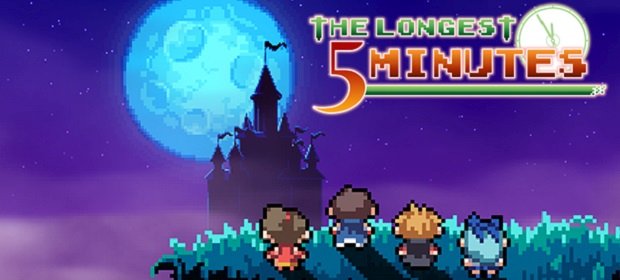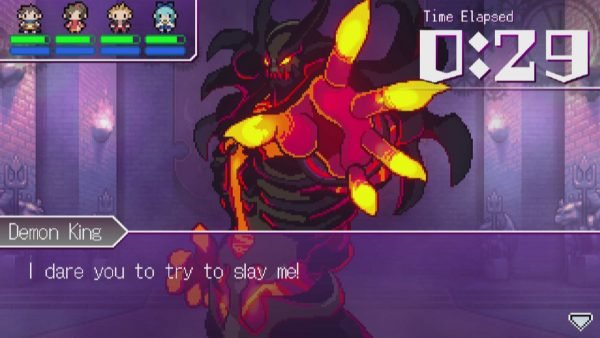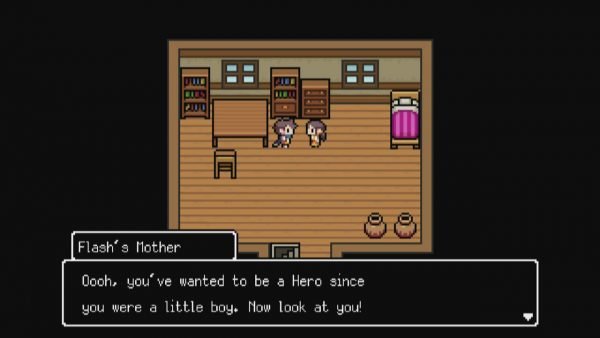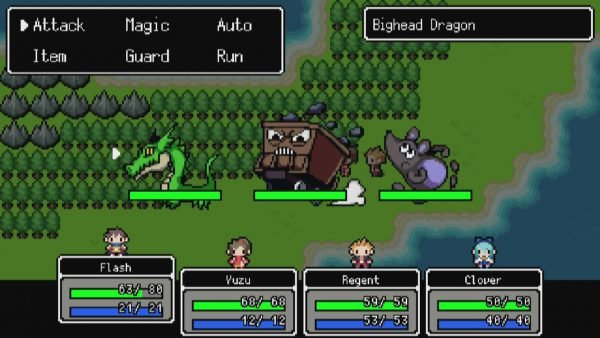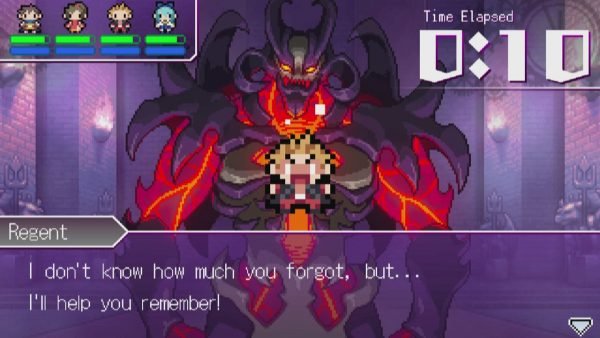Switch to: German
Starting the game already at the final boss is not exactly something commonplace in JRPGs, but that’s exactly the premise behind The Longest Five Minutes. It’s a shame that there is not much else that’s actually unique about the game aside from this gimmick.
Opening with the inventively named Flash Back finding himself faced with the Demon King, the player is left just as confused as the main character. With no memories of why he’s there or who the other people in his party are, Flash must use the next five minutes to figure out what is happening while also defeating the final boss of his forgotten adventure.
Gameplay in The Longest Five Minutes is split between two different genres. The present time sections against the Demon King are represented as a visual novel, with the occasional choice allowing you to alter certain scenes. Whenever Flash has to recall one of his memories the game switches to an old-school themed JRPG, resembling the early Dragon Quest games.
The present time VN sections are the strongest part of the game. Flash actually has a personality, unlike the RPG sections where he is mute the entire way through, and there is nothing interrupting the story. The writing in The Longest Five Minutes is pretty strong for the first few hours, with the game featuring some likeable characters. Unfortunately, the story ends up being rather generic overall once you get used to the flashback gimmick. There are still some decent scenes here and there, but it’s clear most thought was put into the opening sections and the latter part of the story was given less love.
Even ignoring the somewhat generic story, the biggest failing of The Longest Five Minutes is the RPG sections. Gameplay is very similar to older JRPGs, with simplistic visuals and turn-based battles. Each memory that Flash recalls is usually rather short, containing a few goals that can be completed for extra XP. Your current party is generally set in stone, but later memories can you a choice of an extra party member.
Completing memories is an easy task, since it usually only requires completing a dungeon or reaching a certain area. Progress is linear and most memories only require exploration of an area or two. The world map is only really there to tie memories together, since there is no real benefit to exploring past areas and there are no secrets to find.
This simplicity extends to town, dungeon, combat… basically the entire game. Buying weapons and items is unnecessary, since these are changed at the start of a memory and better equipment is usually easy to find in chests. Levelling is also fairly redundant, since each memory has its own level that it locks your party to. Winning battles and beating the aforementioned goals will give XP towards “re-experience levels” that add to your base level, but enemies are so weak that levels are a non-issue either.
This brings us to the biggest issue the game has: What reason is there to fight enemies, or even to explore dungeons fully. And aside from the occasional extra objective, there really is no reason to spend more time than needed fighting random battles or going down a different path just to grab a treasure chest. This leads to gameplay consisting of using simply using a skill/item to avoid enemy encounters then booking it to the next story event.
The Longest Five Minutes would have honestly been more enjoyable if the RPG sections were just replaced with the visual novel style of the present day sections. Having the memories be handled primarily through dialogue and Flash’s thoughts instead of bland exploration and battles would have really helped flesh out the story more. That, and after trawling through cookie cutter dungeons we had a hard time even caring about the game’s world any more.
At least The Longest Five Minutes‘ visuals and soundtrack are handled well. The sprite art is crisp and emulates the style of old JRPGs well without looking too generic. Character art and monster designs are a definite highlight, the amount of detail and personality they managed to put into such small character sprites is impressive. The various battle and dungeon themes also came as a surprise, making trudging through another linear area just a little bit more bearable.
Conclusion
At the end of the day, can we recommend The Longest 5 Minutes? No, not really, especially considering the game’s price in the UK and Europe. Those looking for an old-school style JRPG already have many better options, and the Half Minute Hero series does a much better job at parodying the genre. That said, a second attempt at the game’s concept with either better gameplay or even a different genre entirely would pique our interest.



